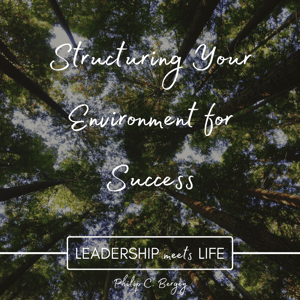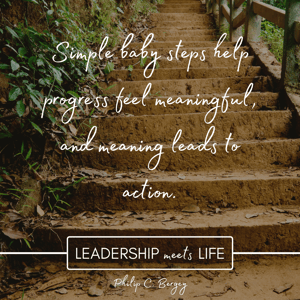
When I began my first executive leadership role in my early thirties, I recall telling a story…
8-year-old girl: Why does daddy work so much?
Mom: He needs to work hard so he doesn't get behind at work.
8-year-old girl: Why don't they put him in a slower group?
And there you have it, from the mouth of babes, as they say. A story that said with a bit of humor what I was feeling.
I wish I had known then what I've learned over the years about the importance of deep breathing. Spending ten minutes intentionally breathing and being aware of my body breathing has been life-changing.
Even a minute is fantastic. And you know what? If all you have is time for seven, or even just three, deep breaths. Do it! Here's a short video of a simple two-minute breathing exercise.
While deep breathing helps leaders stay calmer, what about making progress?
In my previous blog post called The Neuroscience of Willpower we looked at why willpower seems so daunting sometimes. Benjamin Hardy, in his book Willpower Doesn't Work, and James Clear, in his best-selling Atomic Habits, and many others, point to the importance of structuring your environment instead of just relying on sheer willpower.
And in my podcast episode 12, Aristotle Says We Are What We Repeatedly Do, we looked at "habit stacking" and other ways to reduce the number of choices for more routine habits and make them part of the fabric of one's leadership and life in general.
Author and online educator Danny Iny defines discipline as choosing "what you want over what you feel like."
I like that definition. It highlights a values conflict and that the way forward is to choose which value we will act upon intentionally.
Structuring Your Environment for Success

Neuroscientist Irena O'Brien, the founder of The Neuroscience School, suggests several evidence-based strategies to increase our ability to make progress every day by structuring our environment. I'll list three: The Progress Principle, Just Start, and Body Budget.
The Progress Principle: Break down large goals into tasks you know you can successfully accomplish. Small tasks can feel like small wins, which help you maintain your dopamine and motivation levels. Small wins increase motivation, which leads to more progress in an upward spiral.
Dopamine is a type of chemical messenger in your body called a neurotransmitter. A key role played by dopamine is to help the body feel pleasure, which helps us strive, focus, and find things interesting in the world around us.
Just Start: Nike's famous trademark slogan (Just Do It) was brilliant marketing. Multiple neuroscience studies have shown that getting up and doing something gets us out of our default mode network and into our executive control network.
The short version is that our brain has two main networks for processing, with a third one that does the switching between the two:
→ Central Executive Network
→ Default Mode Network
→ and Salience Network
The Salience Network is constantly scanning our body and any signals it's getting from inside our body or from the environment around us. It uses that scanning to decide when something is important enough for us—that is, salient enough—to switch from the Default Mode Network into the Central Executive Network.
The Default Mode Network is simply what it says: it's the default mode when we're not engaged in a task or conscious effort of any kind.
The opposite network from the Default Mode is the Central Executive Network—that leadership center activated by the Salience Network to respond to a threat, engage in a task, or pursue an intentional process.
Practically speaking, we do our best listening, thinking, and problem-solving when we can remain focused in that Central Executive Network.
 The best way to get out of our Default Mode Network and into action is to get out of your head and (literally) into the room, as neuroscientist Dr. Irena O'Brien says. That is, if you feel stuck, just begin. Simple baby steps help progress feel meaningful, and meaning leads to action.
The best way to get out of our Default Mode Network and into action is to get out of your head and (literally) into the room, as neuroscientist Dr. Irena O'Brien says. That is, if you feel stuck, just begin. Simple baby steps help progress feel meaningful, and meaning leads to action.
For more on these parts of the brain, see my blog post, Emotions and Decision-Making.
So when we simply "get up and get going," we are switching from our Default Mode Network and into our Central Executive Mode Network.
Body Budget: Our body has a budget! Who knew?
In her fun-to-read book Seven and A Half Lessons About the Brain, Neuro-phycologist Lisa Feldman Barrett highlights that our brain's primary purpose is to keep our body alive. And to do this efficiently, our brain budgets how, when, and where to expend the body's limited resources.
So with that awareness, you can see how important it is to make the proper investments to get the most from our body budget. Investments include a healthy diet, enough exercise, and optimal sleep.
As O'Brien notes, "a lack of motivation may really be due to an unbalanced body budget."
-1.png?width=168&name=Application%20(2)-1.png)
- Breathe! Seriously. In addition to the automatic breathing, your body does for you, learn the art and science of deep breathing. It will give you energy and help you stay calmer.
- Remember to break down large projects into small tasks. The winning formula is: Small tasks = Wins -> Motivation
- You don't need to remember the names of the brain processing networks. Just remember what Irena O'Brien says, get out of your head and into the world. Beginning to do something, especially something you need to do, helps you start the flywheel of motivation.
- Your body has a budget, and like any budget, it needs to stay balanced for you to make your contribution to the world. Eat. Exercise. Sleep.

Next month my Leadership Meets Life Blog and Podcast will focus on the neuroscience of creativity and problem-solving!
If you haven't already done so, check out my Leadership Meets Life Podcast!

- Primary Source: The Neuroscience School, led by Dr. Irena O’Brien
- Book: Lisa Feldman Barrett, Seven and A Half Lessons About the Brain
- Book: James Clear, Atomic Habits
- Video: Rachel Richards, Calm Your Anxiety in Two Minutes
- Video: James Clear, Atomic Habits: How to Get 1% Better Every Day
Let me know how you’re connecting with the Leadership Meets Life Blog and Podcast. I’d love to hear from you! You can reach me directly at philb@designgroupintl.com or by visiting my website.
/Philip%20C.%20Bergey%20Headshot%20(300x300).png)
May 24, 2022
.png?width=100&name=Phil%20Bergey%20Headshot%20(1).png)






Comments